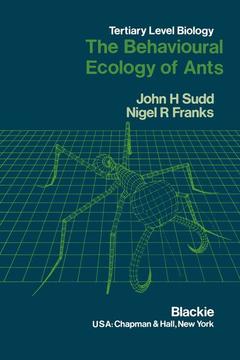The Behavioural Ecology of Ants, Softcover reprint of the original 1st ed. 1987 Developments Series
Langue : Anglais

This book is concerned with two problems: how eusociality, in which one individual forgoes reproduction to enhance the reproduction of a nestmate, could evolve under natural selection, and why it is found only in some insects-termites, ants and some bees and wasps. Although eusociality is apparently confined to insects, it has evolved a number of times in a single order of insects, the Hymenoptera. W. Hamilton's hypothesis, that the unusual haplodiploid mechanism of sex determination in the Hymenoptera singled this order out, still seems to have great explanatory power in the study of social ants. We believe that the direction, indeed confinement, of social altruism to close kin is the mainspring of social life in an ant colony, and the alternative explanatory schemes of, for example, parental manipu lation, should rightly be seen to operate within a system based on the selective support of kin. To control the flow of resources within their colony all its members resort to manipulations of their nestmates: parental manipulation of offspring is only one facet of a complex web of manipul ation, exploitation and competition for resources within the colony. The political intrigues extend outside the bounds of the colony, to insects and plants which have mutualistic relations with ants. In eusociality some individuals (sterile workers) do not pass their genes to a new generation directly. Instead, they tend the offspring of a close relation (in the simplest case their mother).
1 Social Behaviour as a Selfish Strategy.- 1.1 Kin selection.- 1.2 Inclusive fitness and sex ratios.- 1.3 Parental care and manipulation.- 1.4 The evolution of polygyny.- 1.5 Dominance hierarchies in workers.- 1.6 Cooperation and competition.- 2 The Phylogeny of Ants.- 2.1 The origin of ants.- 2.2 The subfamilies of ants.- 3 Ant Economics.- 3.1 Economies of scale.- 3.2 Colony life-history strategies.- 3.3 The flow of resources within the colony.- 3.4 Nest construction.- 4 Who does What, and When?.- 4.1 How ants are employed: how many tasks are performed in antcolonies?.- 4.2 Temporal polyethism: production lines based on an age-baseddivision of labour.- 4.3 Conflicts over the division of labour.- 4.4 Physical castes.- 4.5 The economics of caste ratios.- 4.6 Caste ratios and social homeostasis.- 5 Communication.- 5.1 Ant signals and language.- 5.2 Recognition of nestmates.- 5.3 Pheromonal communication.- 5.4 Communication in recruitment.- 5.5 Sex pheromones.- 6 Ants as Partners.- 6.1 Ants in the ecological community.- 6.2 Ants and plants.- 6.3 Ants and other insects.- 6.4 The cost-benefit balance in mutualism.- 7 Ants Exploiting Ants.- 7.1 Types of exploitation.- 7.2 The temporary and permanent parasitic ants.- 7.3 The evolution of inquilines.- 7.4 Slavery.- 8 Ant Ecology.- 8.1 Competition.- 8.2 Economics of territorial defence.- 8.3 Foraging for the most profitable prey.- 8.4 Ants as predators and prey: army ant foraging ecology.- References.
Date de parution : 08-2014
Ouvrage de 206 p.
15.2x22.9 cm
Thèmes de The Behavioural Ecology of Ants :
Mots-clés :
Fitness; adaptation; behavior; ecological community; ecology; evolution; homeostasis; insect; insects; mutualism; parasites; phylogeny; predator; reproduction; social behavior
© 2024 LAVOISIER S.A.S.



